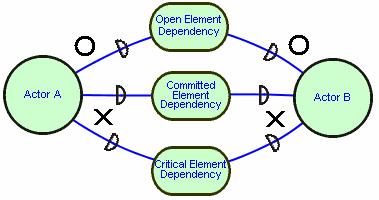This open version of the Guide Wiki Page displays the i* construct as per the i* Style of the University of Toronto. Use Comment tab above to read or write comments about this i* construct. Scroll down to see variations of this construct for other i* modeling styles.
4.4 Vulnerability
Vulnerability is implied with Dependency Link(s). The dependency link represents that the depender, by depending on the actor who is the dependee, is able to achieve goals that it was not able to achieve before, or not as well, or not as quick. However this results in the depender becoming vulnerable to the intentions of the dependee. This vulnerability is implied because the dependee may fail to accomplish the specified element.
The model distinguishes three degrees of strength for the dependency according to the level of vulnerability. These types of dependencies apply independently on each side of a dependency. They are described in the following:
- Open dependency (uncommitted): Not obtaining the dependum would affect the depender to some extent but not seriously. This dependency strength is represented by including an "O" on the appropriate side of the link.
- Committed dependency: Not obtaining the dependum would cause some action for achieving a goal to fail in the depender.
- Critical dependency: Not obtaining the dependum would cause all actions to fail that the depender has planned to achieve a goal. This dependency strength is represented by including an "X" on the appropriate side of the link.

Return to the stable version of this page
Instructions for Guideline authors/contributors
Below is the space designated to post possible variations. Please do not edit or alter the original guideline above.
Please provide the following information for each variation:
1. Name of Modeling Framework/School/Location/Research Group
2. Variation and explanation
3. Example(s)
Learn how to upload and use an image in the wiki page
You can use the Comment tab to post additional comments about this guideline or its variations outside this space. The Comment tab displays your comments at the bottom of this page. (Do not use the Discuss tab).
Add variations here.
Return to the stable version of this page
